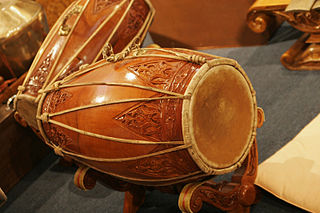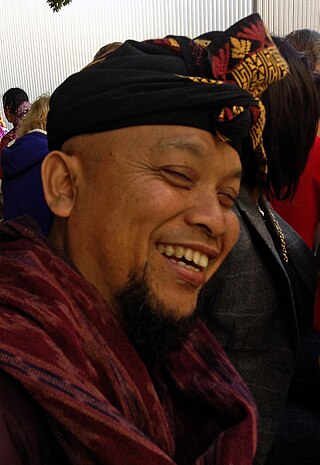History
Founded in 1979 by I Wayan Suweca, Rachel Ann Cooper and Michael Tenzer, Gamelan Sekar Jaya (GSJ) was the first community-based Balinese gamelan in the United States. [4] Most of its performers are American volunteers, taught and led in performance by visiting Balinese master artists. [5] [6]
Popular both in the States and abroad, the group has performed all over North America and has toured Bali seven times (1985, 1992, 1995, 2000, 2003, 2010, and 2014). [7] In 2000, Gamelan Sekar Jaya was awarded the Dharma Kusuma Award for Cultural Service by the Balinese government, the highest such honor given. [8] The group regularly performs locally. [9] [10]
Gamelan is the Indonesian term for orchestra, and the name "Sekar Jaya" translates roughly to "Victorious Flower." [11]

Gamelan is the traditional ensemble music of the Javanese, Sundanese, and Balinese peoples of Indonesia, made up predominantly of percussive instruments. The most common instruments used are metallophones and a set of hand-drums called kendang, which keep the beat. The kemanak, a banana-shaped idiophone, and the gangsa, another metallophone, are also commonly used gamelan instruments on Bali. Other notable instruments include xylophones, bamboo flutes, a bowed string instrument called a rebab, and a zither-like instrument called a siter, used in Javanese gamelan. Additionally, vocalists may be featured, being referred to as sindhen for females or gerong for males.

Evan Ziporyn is an American composer of post-minimalist music with a cross-cultural orientation, drawing equally from classical music, avant-garde, various world music traditions, and jazz. Ziporyn has composed for a wide range of ensembles, including symphony orchestras, wind ensembles, many types of chamber groups, and solo works, sometimes involving electronics. Balinese gamelan, for which he has composed numerous works, has compositions. He is known for his solo performances on clarinet and bass clarinet; additionally, Ziporyn plays gender wayang and other Balinese instruments, saxophones, piano & keyboards, EWI, and Shona mbira.

Jegog is a form of gamelan music indigenous to Bali, Indonesia, played on instruments made of bamboo. The tradition of jegog is centered in Jembrana, a region in Western Bali. In recent years jegog has started to become popular in other regions of Bali with a few groups being established in central Bali to entertain tourists. International interest has been spread by tourists visiting Bali and by recordings. There are virtually no ensembles outside of Bali with the exception of at least two groups in Japan, one in the United States and one in Germany. Jegog music is very fast, loud, rhythmic and precise. Pieces last from a few minutes to as long as thirty minutes.

Michael Tenzer is a composer, performer, and music educator and scholar.

Joged bumbung is a style of gamelan music from Bali, Indonesia on instruments made primarily out of bamboo. The ensemble gets its name from joged, a flirtatious dance often performed at festivals and parties. This style of Gamelan is especially popular in Northern and Western Bali, but is easily found all over the island. Unlike many styles of Balinese Gamelan which have sacred roles in religious festivals, Joged music is much more secular, and in many ways has become the folk music of Bali. With the rapid rise of tourism in recent decades, Joged music is now often found being performed at hotels and restaurants.

Legong: Dance of the Virgins is a 1935 drama travelogue silent film, one of the last feature films shot using the two-color Technicolor process, and one of the last silent films shot by a major Hollywood studio. It is a drama based on a Balinese native tale, with travelogue elements depicting Balinese culture. Legong and the follow-up travelogue drama Kliou, the Killer were the last mainstream silent films to be released in the US.

Gamelan semar pegulingan is an old variety of the Balinese gamelan. Dating back from around the 17th century, the style is sweeter and more reserved than the more popular and progressive Gamelan Gong Kebyar. Semar pegulingan is derived from the ancient flute ensemble gamelan gambuh which utilizes a 7 tone scale. Semar pegulingan also uses the 7 tone scale which enables several pathet to be played. Semar is the name of the Hindu God of love and pegulingan means roughly 'laying down'. It was originally played near the sleeping chambers of the palace to lull the king and his concubines to sleep. The ensemble includes suling, various small percussion instruments similar to sleigh bells and finger cymbals, and trompong - a row of small kettle gongs that play the melody. A similar type of ensemble, Gamelan Pelegongan, substitutes a pair of gendérs for the trompong as the melody carrier and plays the music for a set of dances known as legong.

A kendang or gendang is a two-headed drum used by people from the Indonesian Archipelago. The kendang is one of the primary instruments used in the gamelan ensembles of Javanese, Sundanese, and Balinese music. It is also used in various Kulintang ensembles in Indonesia, Brunei, Malaysia, Singapore, and the Philippines. It is constructed in a variety of ways by different ethnic groups. It is related to the Indian double-headed mridangam drum.

Gamelan, although Indonesia is its origin place, is found outside of that country. There are forms of gamelan that have developed outside Indonesia, such as American gamelan and Malay Gamelan in Malaysia.

Gamelan gender wayang is a style of gamelan music played in Bali, Indonesia. It is required for wayang and most sacred Balinese Hindu rituals. The smallest of gamelan ensembles, it requires only two players and is complete at four, the additional instruments doubling an octave above. Like other gamelan genres, it incorporates delicate interlocking melodies and active contrapuntal movement, yet poses unique challenges in technique and composition.

Balinese dance is an ancient dance tradition that is part of the religious and artistic expression among the Balinese people of Bali island, Indonesia. Balinese dance is dynamic, angular, and intensely expressive. Balinese dancers express the stories of dance-drama through bodily gestures including gestures of fingers, hands, head, and eyes.

Richard Marriott is an American composer and performer. He has composed for film, television, dance, theater, opera, installations and video games. He is the founder and artistic director of the Club Foot Orchestra, an important modern ensemble for live music performance with silent films. His teachers include Dominick Argento and Paul Fetler at the University of Minnesota, Pauline Oliveros at UCSD, North Indian sarod master Ali Akbar Khan, shakuhachi master Masayuki Koga, and Balinese composers Nyoman Windha and Made Subandi. Marriott was a member of Snakefinger's History of the Blues and has recorded with The Residents, Brazilian Girls, "Singer at Large" Johnny J. Blair, and many others. He performs on brass and woodwind instruments, Western and Asian.
I Wayan Suweca is a highly respected performer of Balinese gamelan. Since the 1970s, he has taught and performed extensively throughout Asia, Europe, and America. In the early 1980s, along with his students Michael Tenzer and Rachel Ann Cooper, he founded and led the famous Sekar Jaya gamelan ensemble in Berkeley, California. In 1993, he cofounded the ensemble Giri Kedaton in Montreal. From 1982 to 2004, he was professor at the National Arts Academy of Indonesia (STSI) in Bali. From 1987 to 1993, he was a guest teacher at Université de Montréal in Canada and in Rochester, USA. For other students, See: List of music students by teacher: R to S#I Wayan Suweca.

Gambuh is an ancient form of Balinese dance-drama. It is accompanied by musicians in a gamelan gambuh ensemble.
Rachel Cooper is an American performing arts presenter specializing in cultural exchange. She is the Director of Global Performing Arts and Cultural Initiatives for the Asia Society. Before joining the Asia Society she headed the Festival of Indonesia which brought over 200 artists to 30 states in the United States. Along with I Wayan Suweca and Michael Tenzer, she co-founded Gamelan Sekar Jaya which was the first community-based Balinese gamelan in the United States.
Christine Southworth is an American composer of postminimal music and works with combinations of Western ensembles, electronics, and world music ensembles including Balinese gamelan and bagpipes. She performs Balinese gamelan and gender wayang with Cambridge, Massachusetts-based Gamelan Galak Tika, as well as Galician Gaita and Great Highland Bagpipes. She co-founded Ensemble Robot, a cooperative of engineers, artists and musicians working together to invent robotic musical instruments. She was also the general manager of Gamelan Galak Tika from 2004 through 2013. Her own music incorporates her work with Balinese gamelan and with technology and electronics, as well as reaching beyond these influences with an expanded palette of contemporary classical, jazz and rock, and world music from Africa, Asia and Eastern Europe.

I Made Subandi was a gamelan composer and performer from Gianyar, Bali.

Balinese theatre and dramas include Janger dance, pendet dance performances, and masked performances of Topèng. Performances are also part of funeral rituals involving a procession, war dance, and other rituals before the cremation of the patulangan. Balinese use the word sesolahan for both theatre and dance.
















